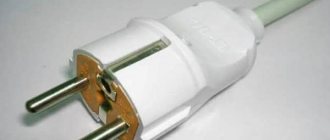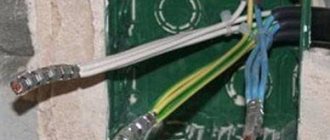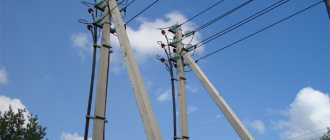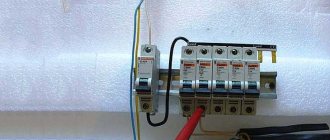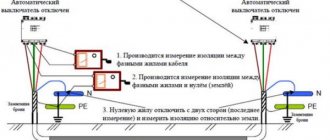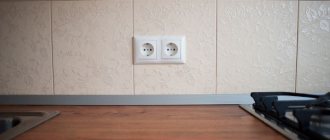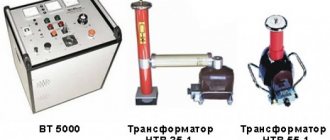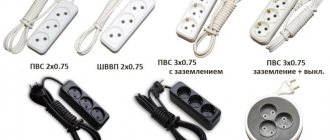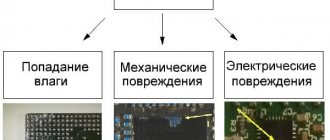Very often, electricians have to connect an electrical installation to an existing line passing by in relative proximity. In other words, it is necessary create a wire branch. An example would be connecting a private house to a 0.4 kV overhead line or connecting an apartment electrical panel to access electric risers. In both of these cases, the line probably runs very close - here they are, the treasured 220 or 380 volts with the necessary power reserve, just a stone's throw away. But how to connect to them?
Since this problem is widespread and has long been known, quite a lot of options for solving it have already accumulated, and in this article we will try to consider them in detail.
The very first way to create a branch that comes to mind is the good old twist. There’s no need to be tricky here - if the wire is insulated (SIP, for example), then it is stripped at the point of contact, and the branch line is wound around it with a large number of turns to ensure a large contact area.
Of course, anyone who decides to twist will have to take into account the following:
- in the book sacred to every electrician - PUE - they speak extremely disapprovingly of twists and practically anathematize them. Therefore, the electrician who performed the twisting takes on increased responsibility;
— twisting is possible only if the material of the main and branch wires is the same. That is, copper - to copper, aluminum to aluminum. Otherwise, the twist will not last long and can cause the most serious problems;
— twisting is worth doing if you are confident that you will do it well and with high quality. If you doubt your experience and qualifications, use special clamps or pads .
Rice. 1. Universal branch terminal block DKS
The pads are approved by the PUE. But there are also a few “buts” here. First, to use the terminal block, the main wire must be cut. This is completely undesirable. Secondly, the terminal block is a screw connection that requires systematic maintenance and wiring of contacts.
This is also not very convenient. Well, thirdly, the terminal block is practically not protected by anything either from precipitation or from mechanical influences. In short, the reliability of the branch connection with the terminal block is very low. Therefore, it is better to use branch clamps .
And such compresses are available in a fairly large assortment. The most popular among them are the so-called “nuts” . Their design is as follows: the main and branch wires are pressed from different sides to an anodized steel contact plate using four screws and plates with grooves. This entire “sandwich” is closed with a carbolite body, which is tightened by two spring rings.
Rice. 2. Branch squeezes (“Nuts”)
The marking of “nuts” includes the letter “U” and a three-digit nomenclature number. Nuts are good because they allow you to connect aluminum and copper wires, since the design of these clamps excludes their direct contact - the steel die is an “intermediary”. In addition, to connect with nuts, the main wire does not need to be cut, and the cross-sections of the connected wires can be very different: from 4 to 150 sq. mm. for main wire and from 1.5 to 120 sq. mm. for branch.
“Nuts” is, of course, good, but I would like more. In particular, it is not very convenient that in order to connect the wires they must be stripped of insulation. And installing “nuts” under voltage is not only inconvenient, it’s simply dangerous. In addition, the degree of protection of the “nut” compression from external influences often leaves much to be desired - only IP20.
Piercing clamps do not have these disadvantages . These clamps are sealed and do not require stripping the main wire, which means they do not impair its performance. The whole secret is in special clamping plates with teeth that can pierce the insulation and ensure electrical contact with the wire.
The tightening force of the compression bolts is adjusted by the breakaway hex head, which means that the piercing clamps are intended for one-time use. The heads of the clamping bolts are electrically isolated from the contact plates, so that the piercing clamps can be installed even under voltage. Most often, such clamps are used when installing overhead lines with SIP wire.
Rice. 3. Sealed piercing clamp ZPO
When installing branch lines in a workshop or residential building, it may be more logical to use OB type clamps. They could also be called “piercing”, and their use does not require any tools or special skills at all.
The connected wires, without stripping the insulation, are placed in a clamp, which is simply snapped into place by hand. At the same time, the brass connector pierces the insulation of the wires and provides a reliable electrical connection. However, OBs connect copper and aluminum wires with a maximum cross-section of only 6 square meters. mm., besides, the cross-section of the main and branch wires should be approximately the same, which is why they are not used very often.
Squeeze the nut
When we looked at the basic ways of connecting wires in a junction box, special attention was paid to a special nut-type clamp. The product has a fairly simple design, but despite this it allows you to make the branch reliable and durable. The compression nut consists of a carbolite body, a steel die and a plate, which actually presses the cores with four screws.
All you need is to place the stripped contacts in a special die and carefully tighten the screws with a screwdriver, then snap the housing into place. You can learn more about nut-type compression from our article.
Pros and cons of welding wires in cars
Welding wires in a car is highly reliable and durable. In factory conditions, welding of contacts is used to create a reliable connection to the ground of the car, and some positive contacts are also combined together using welding. An undeniable advantage is that the welded joint has minimal resistance.
However, using it for repair purposes is very expensive and often inconvenient.
Piercing clamps
An improved model of nut cable compression are piercing clamps. Disposable products, however, allow you to make a wire branch without cutting and even without peeling off the insulating layer when splicing. The design of the clamp is represented by a hexagonal head, which tightens the conductors, as well as contact plates with teeth, which actually pierce the insulating material.
They are most often used to branch from an overhead line laid with SIP wire without relieving the voltage.
The advantage of these products is as follows:
As for the disadvantages, the main thing is only the “disposability” of the product, however, this point is very controversial, given the durability of this method of branching wires without breaking.
Installation is carried out as follows:
Clamp type OB
When repairing or replacing electrical wiring in an apartment, you can use another pretty good option for splicing wires - using OB type clamps. The products have a simple design and an equally simple operating principle - the cable is placed in a special latch, which uses a brass connector to pierce the conductor insulation layer. As a result, in a matter of seconds you can make a good branch from the main power cable (for example, to a socket).
Such connectors are also called “Scotchlocks”. You can learn more about what Scotchlocks are and how to use them in our separate article: https://samelectrik.ru/skotchloki-dlya-soedineniya-provodov.html.
Video instructions for using a latch to branch a wire without cutting:
Pros and cons of soldering wires in cars
In most electrical work, soldering can be a very reliable connection, but it is not recommended for use in cars. This is due to the fact that the soldered contact is susceptible to oxidation, which will provoke rapid destruction of the connection. A soldered connection has no flexibility and with minimal physical impact, contacts that have rotted will disintegrate.
It is not the soldering itself that deteriorates. The weak points of such a connection are located between the insulating layer of the wire and the soldering itself. Oxidation will occur here, which will provoke a breakdown.
Also among the negative aspects is the inconvenience of this method. Trying to solder contacts under the dashboard, where even primitive twisting cannot always be done properly, is very inconvenient.
A reliable soldered joint can be achieved by covering the twist with solder and covering the joint with a special varnish that will prevent oxidation.
Polyethylene terminal blocks
A more outdated method of branching a wire is to use terminal blocks (they are also called polyethylene terminal blocks). It is not recommended to use compact terminal blocks, because... in this case, it is impossible to do without cutting and tearing the main core. In addition, the terminal block also has such disadvantages as poor sealing and the need to periodically tighten the clamping screw, especially if the conductor is aluminum. As a result, you do not get any important advantages when splicing and at the same time you get several serious disadvantages.
Grandfather's twist
Well, the last method of branching wires that can be used is to twist a new line from the passing main line without additional soldering or welding. In this case, you must first strip the insulation of the conductors, after which the branch line must be screwed tightly onto the main line (as shown in the picture).
Please note that when creating twisting, it is prohibited to connect aluminum and copper conductors. Conductors must be made of the same metal. According to clause PUE 2.1.21. (Chapter 2.1 PUE) twisting cannot be done at all - all connections must be soldered, welded, crimped or fixed with clamps or terminal blocks. Therefore, to branch from the wire, use the above methods or solder such twists. We talked more about how to make twists in the article: https://samelectrik.ru/kak-pravilno-sdelat-skrutku-provodov.html.
So, in fact, we looked at the most popular methods of branching wires without breaking or cutting. Now you know how you can make a high-quality splice of two power lines. Our advice is to use piercing clamps, which are the most trustworthy of all the options!
Related materials:
Source
Tips from experienced installers
There are many controversial issues both in connection methods and in the use of individual mounting products. But a number of rules apply to absolutely all craftsmen who do electrical installations.
For example, it is strictly prohibited to twist aluminum conductors with copper ones. The process of rapid oxidation leads to the destruction of the commutation and the creation of a dangerous point, which can spark or flare up at any time.
A few more important rules:
Image gallery
Photo from
Properly executed twisting
Maximum connection isolation
The importance of marking conductors
If the conductor is covered with an oxide film, it must be carefully removed using either contact paste or fine sandpaper. It is better to select the diameters of sleeves, tips, caps according to size.
When using electrical tape, overlap the wraps. One layer is not enough, it is better to go along the connection 2-3 times, making sure to make the last turn on the insulation
Single conductors in screw terminals are held loosely. Therefore, it is recommended to bend the stripped end in half or make an arbitrary loop out of it.
At the end of the work, be sure to check the reliability of the connections - lightly tug the wires. It happens that the switching is unsuccessful, and the core simply slips out of the terminal block.
If the volume of the distribution box allows, for example, the panels accommodate a lot of wires and devices, then leave the cable with a reserve. Sometimes switching is required and the extra length is useful if the connections are permanent or burnt.
Subscribe to the newsletter
Choosing a method for connecting cable cores and wires when installing electrical wiring is a responsible task. It is necessary to take into account a combination of factors, including the cross-section and material from which the cores are made, working conditions, as well as the availability of the necessary tools for the job. In this article we will talk about the most common methods of connecting conductors.
Terminal blocks
A relatively simple connection method, often used in junction boxes and also for connecting lighting fixtures. The terminal block is a brass bushing placed in a plastic housing. To secure the wire inside it, you must firmly tighten the screws by hand using a screwdriver.
It is important that the size of the terminal block matches the cross-section of the cable or wire. If you need to connect stranded conductors, you must first crimp them using lugs (for example, NShVI).
The main disadvantage of terminal blocks is the ability to connect only two conductors. They also cannot be used to connect cores made of dissimilar metals (for example, copper and aluminum).
How to properly connect wires to each other under voltage
- welding is the most reliable method, ensuring high reliability of the connection, but requiring skills and the presence of a welding machine;
- terminal blocks - a simple and fairly reliable connection;
- soldering - works well if the currents do not exceed the norm and the connection does not heat up to temperatures above the norm (65°C);
- crimping with sleeves - requires knowledge of technology, special pliers, but the connection is reliable;
- use of spring clamps - wago, PPE - are quickly installed and, subject to operating conditions, ensure good contact;
- bolted connection - easy to perform, usually used in difficult cases - when it is necessary to switch from aluminum to copper and vice versa.
Connecting electrical cables
Let's start by connecting the electrical wires. Let's assume that we have three wires going into the electrical box, and they need to be connected to each other. How it's done? First, you need to cut off the excess cable and leave the cable at such a length that it does not interfere with the placement of the cables in the electrical box, but at the same time it is not too short, because a cable that is too short cannot be properly stripped and cannot be connected properly. It should extend about 5 cm out of the box, then we will trim it anyway.
Now we do the following: we strip each cable to a length of approximately 2–2.5 cm. We carefully cut it, trying not to damage the inner conductor. Here the technology is the same for all types of conductors - aluminum, copper, single-core and stranded.
We twist the veins. You can twist them in any direction you like.
To do this, you can use pliers or your own hands, if you don’t mind them. Naturally, only multi-core cables are twisted. If you have a single-core cable, then we simply strip it. We perform the same procedure with the second cable, then with the third: remove the insulation, strip it, twist it. Then we take two cables, lean them against the insulation and tightly twist them like this:
Next, we apply the third cable, also insulation to insulation, and as tightly as possible - this is very important for the further operation of your electrical wiring - we wind it onto the other two cables.
Most electricians recommend that after twisting, you cut the twist where the last cable ended. It ends a little earlier than the other two.
Why is this being done? First, we bite off the excess. We don’t need a strongly protruding twist, it’s inconvenient to insulate, and it won’t fit well in the box. Secondly, we get something like cold welding.
How to properly connect live wires?
- Increase the maintainability of electrical networks. Since all connections are accessible, the nature of the problem can be easily determined and the problem can be quickly resolved.
- Connection locations present the greatest potential for malfunctions. Easy access to connections allows for regular inspection.
- Reduce the level of fire safety, since constant inspection allows for a timely response to emergency operating conditions.
- Reduce the cost of purchasing electrical wires or cables. Electrical wiring made without junction boxes requires a lot of materials.
Useful tips Connection diagrams Principles of operation of devices Main concepts Meters from Energomer Precautions Incandescent lamps Video instructions for the master Testing with a multimeter
Splicing electrical cables
The cables have to be spliced in the electrical box or outside it. To do this, you need to strip these cables in the same way as in the previous example. We make cuts, remove insulation, and strip the cables. In order to splice the cables, we lay them crosswise:
We twist them, about 3-4 turns, and we get a fairly strong twist:
You can use pliers for this work. We work with them, trying to ensure that the cable does not diverge.
If desired, if you have a soldering iron, you can also solder this connection to give it additional strength. If you don’t have a soldering iron, you can do it this way. We begin to isolate the resulting twist. We take electrical tape, start about a centimeter before the connection and insulate it.
We also go about a centimeter from the other edge and return to improve the dielectric properties of our connection with a second layer. We bite off the excess electrical tape.
That's it - we spliced the cable.
